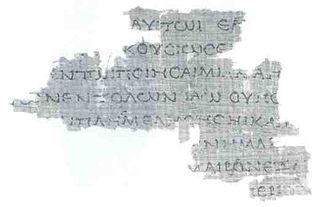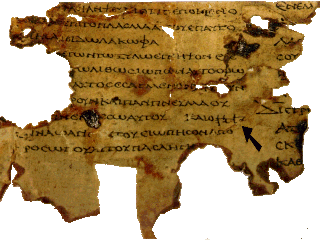In contrast to the variety of absolute or personal names of God in the Old Testament, the New Testament uses only two, according to the International Standard Bible Encyclopaedia. From the 20th century onwards, "a number of scholars find various evidence for the name [YHWH or related form] in the New Testament.

The Tetragrammaton, or the Tetragram, is the four-letter Hebrew theonym יהוה, the name of God in the Hebrew Bible. The four letters, written and read from right to left, are yodh, he, waw, and he. The name may be derived from a verb that means "to be," "to exist," "to cause to become," or "to come to pass." While there is no consensus about the structure and etymology of the name, the form Yahweh is now accepted almost universally, though the vocalization Jehovah continues to have wide usage.
The New English Translation of the Septuagint and the Other Greek Translations Traditionally Included under That Title (NETS) is a modern translation of the Septuagint (LXX), that is the scriptures used by Greek-speaking Christians and Jews of antiquity. The translation was sponsored by the International Organization for Septuagint and Cognate Studies (IOSCS). The Psalms were published in 2000 and the complete Septuagint in 2007.

Codex Marchalianus designated by siglum Q is a 6th-century Greek manuscript copy of the Greek version of the Hebrew Bible known as the Septuagint. The text was written on vellum in uncial letters. Palaeographically it has been assigned to the 6th century. Marginal annotations were later added to the copy of the Scripture text, the early ones being of importance for a study of the history of the Septuagint.

Papyrus Rylands 458 is a manuscript of the Pentateuch in the Greek Septuagint version of the Hebrew Bible. It is a roll made from papyrus, which has survived in a very fragmentary condition. It is designated by the number 957 on the list of Septuagint manuscripts according to the numbering system devised by biblical scholar Alfred Rahlfs. Using the study of comparative writing styles (palaeography), the manuscript has been dated to the middle of the 2nd century BCE.

Papyrus 967 is a 3rd-century CE biblical manuscript, discovered in 1931. It is notable for containing fragments of the original Septuagint text of the Book of Daniel, which was completely superseded by a revised text by the end of the 4th century and elsewhere survives only in Syriac translation and in Codex Chisianus 88. The manuscript is also important for early variants, both in the text of the Book of Ezekiel and of the Book of Daniel.

The manuscript 4Q120 is a Septuagint manuscript (LXX) of the biblical Book of Leviticus written on papyrus, found at Qumran. The Rahlfs-No. is 802. Paleographically it dates from the first century BCE. Currently the manuscript is housed in the Rockefeller Museum in Jerusalem.

Papyrus Oxyrhynchus 1007 is a fragment of a Greek Septuagint manuscript written on parchment. The manuscript was discovered in Oxyrhynchus, modern El-Bahnasa, Egypt. Using the study of comparative writing styles (palaeography), the manuscript has been dated to the 3rd century CE.

The Greek Minor Prophets Scroll from Nahal Hever is a Greek manuscript of a revision of the Septuagint dated to the 1st century BC and the 1st century CE. The manuscript is kept in the Rockefeller Museum in Jerusalem. It was first published by Dominique Barthélemy in 1963. The Rahlfs-Siglum is 943.

The Papyrus LXX Oxyrhynchus 3522, – is a small fragment of the Greek Septuagint (LXX) written in papyrus, in scroll form. As one of the manuscripts discovered at Oxyrhynchus it has been catalogued with the number 3522. Palaeographically it has been dated to the 1st century CE. The text agrees with the LXX.

Papyrus Oxyrhynchus 5101, designated by 2227, or P.Oxy.77 (LXXVII) 5101, is a manuscript of the Greek Septuagint Psalms, written on papyrus in roll form. It has survived in a very fragmentary condition. Using the study of comparative writings styles (palaeography), it has been dated to the middle of the first - middle of the second century CE.

The AqBurkitt are fragments of a palimpsest containing a portion of the Books of Kings from Aquila's translation of the Hebrew bible from the 6th century, overwritten by some liturgical poems of Yanai dating from the 9–11th century. This Aquila translation was performed approximately in the early or mid-second century C.E. The manuscript is variously dated to the 6th-century CE, or 5th-6th century CE.
Papyrus Berlin 17213 is Koine Greek fragment of the Septuagint dated to the 3rd century CE.

Papyrus Oxyrhynchus 656 – is a Greek fragment of a Septuagint manuscript written on papyrus in codex form. This is a manuscript discovered at Oxyrhynchus, and it has been catalogued with number 656. Palaeographycally it is dated to late second century or early third century.
P. Lond.Lit.207 is a Greek fragment of a Septuagint manuscript written on papyrus in codex form. This manuscript discovered at Fayum, contains parts of the Book of Psalms. Palaeographycally it is dated to late third century or early fourth century.
Papyrus Oxyrhynchus 4443 is a fragment of a Septuagint manuscript (LXX) written on papyrus in scroll form. It is the oldest extant manuscript that contains Esther 8:16–9:3 of the Septuagint text and verse numbering. according to the text of LXX. The manuscript has been assigned palaeographically to 50–150 CE.
The Papyrus Chester Beatty V is a fragment of a Greek Septuagint manuscript written on papyrus. It belongs to the Chester Beatty papyri. Using the study of comparative writing style (palaeography), it has been dated to the late 3rd century CE.
The Papyrus Deissmann is a septuagint manuscript written in papyrus that contains parts of the Book of Exodus. Using the study of comparative writing styles (palaeography), it has been dated to 3rd-century. Currently is kept at Armidale, Private collection, Australia.
The Papyrus Leipzig Inv. 170 is a fragment of a septuagint manuscript written on papyrus in codex form that contains part of the Psalms. Palaeographically it has been dated to the 3rd century CE.
The Papyrus Chester Beatty VIII is a fragment of a septuagint manuscript that contains parts of the biblical Book of Jeremiah. Palaeographically it has been dated to the late second, early third century CE.











